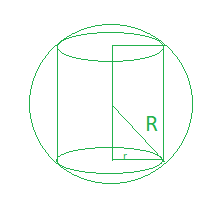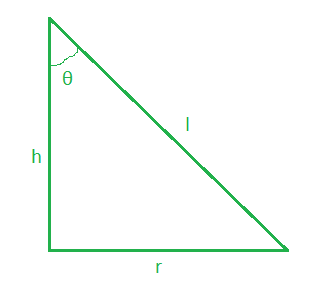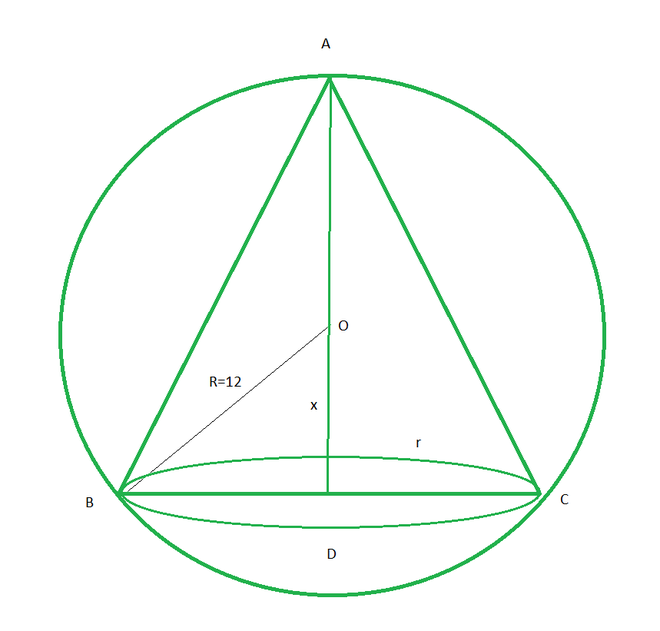问题16.大窗户的形状是矩形,上面有一个等边三角形。如果窗口的周长为12米,请找到将产生窗口最大面积的矩形的尺寸。
解决方案:

According to the question
Let us assume l be the length of the rectangle and b be the breadth of the rectangle
The perimeter of the window = 12 m
⇒ (l + 2b) + (l + l) = 12
⇒ 3l + 2b = 12 ……(i)
Mow we find the area of the window (A) = Area of the rectangle + Area of the equilateral △
A = l (12 – 3l / 2) + √3/4 l2
On differentiating w.r.t. l, we get
dA/dl = 6 – 3l + (√3/2)l = 6 – √3(√3 – 1/2)l
For maxima and minima,
Put dA/dl = 0
⇒ 6 – √3(√3 – 1/2)l = 0
⇒ l = 6/{√3(√3 – 1/2) } = 12- (6 – √3)
Now, d2A/dl2 = -√3(√3 – 1/2) = -3 + √3/2
So, l = 12/(6 – √3) is the point of local maxima
So, When l = 12/(6 – √3), the area of the window is maximum
From eq(i), we get
b = (12 – 3l)/2 = [12 – 3{12/(6 – √3)}]/2 = (24 – 6√3)/(6 – √3)
问题17:证明可以在半径为R的球体内切出的最大容积圆柱体的高度为2R /√3。另外,找到最大音量。
解决方案:
According to the question
R be the radius of the sphere
So, let us assume that r and h be the radius and the height of the cylinder

So, according to the image
h = 2 √(R2 – r2)
Now we find the volume of the cylinder is
V = πr2h = 2πr2√(R2 – r2)
On differentiating w.r.t. r, we get
dV/dr = 4πr √(R2 – r2) + ![]()
= 4πr √(R2 – r2) – ![]()
= ![]()
= ![]()
For maxima and minima,
Put dV/dr = 0
4πrR2 – 6πr3 = 0
r2 = 2R2/3
Now, again differentiating w.r.t. r, we get
d2V/dr2 = 
= 
= 
So, at r2 = 2R2/3, d2V/dr2 < 0
Hence, the volume is the maximum when r2 = 2R2/3
so, the height of the cylinder = 2√(R2 – 2R2/3) = 2√(R2/3) = 2R/√3
Hence proved
问题18:在半径为r的半圆中刻有一个矩形,其矩形的边之一为半圆的直径。找到矩形的尺寸,以便其最大面积。同时找到该面积。
解决方案:
Let us assume EFGH be a rectangle inscribed in a semi-circle. So, r be the radius of the semicircle.
And l and b are the length and width of rectangle.

Now In △OHE,
HE2 = OE2 – OH2
HE = b = ![]() …..(i)
…..(i)
Now we find the area of the EFGH rectangle
A = lb = l × ![]()
A = 1/2 l √(4r2 – l2)
On differentiating w.r.t. l, we get
dA/dl = 1/2 \sqrt{4r^2-l^2}-\frac{l^2}{\sqrt{4r^2-l^2}}
= 1/2 \frac{4r^2-l^2-l^2}{\sqrt{4r^2-l^2}}
= ![]()
For maxima and minima,
Put dA/dl = 0
⇒ ![]()
⇒ l = ±√2r
As we know that l can’t be negative so l ≠ -√2r
So, when l = √2r, d2A/dl2 < 0
Hence, the area of the rectangle is maximum when l = √2r
Now put the value of l = √2r in eq(i), we get
![]()
Now we find the area of rectangle = lb
= √2r × r/√2
= r2
问题19.证明当高度为基部半径的√2倍时,给定容量的圆锥形帐篷所需的帆布量最少。
解决方案:
Let us assume that the radius and height of the cone is r and h.
So, the volume of the cone is
V = 1/3 πr2h
h = 3V/r2 ……(i)
And the surface area of the cone is
A = πrl
Here, l is the slant height = √(r2 + h2)
= πr√(r2 + h2)
= ![]()
On differentiating w.r.t. r, we get
dA/dr = 
= ![]()
For maxima and minima,
Put dA/dr = 0
2π2r6 = 9V2
r6 = 9V2/2π2
When, r6 = 9V2/2π2, d2S/dr2 > 0
Hence, the surface area of the cone is the least when r6 = 6V2/2π2
Now put r6 = 9V2/2π2 in eq(i), we get
h = 3V/πr2 = 3/πr2(2π2r6/9)1/2 = (3/πr2)(√2πr3/3) = √2r
Hence Proved
问题20:证明在给定球体中可以接切的最大体积的圆锥体的高度等于球体直径的2/3。
解决方案:
Let us assume R be the radius of the sphere

So, from the figure, we get OD = x and AO = OB = R
BD = √(R2 – x2) and AD = (R + x)
Now,
The volume of the cone is
V = 1/3 πr2h
= 1/3 πBD2 × AD
= 1/3 π (R2 – x2) × (R + x)
On differentiating w.r.t. x, we get
dV/dx = π/3 [-2x (R + x) + R2 – x2]
= π/3 [R2 – 2xR – 3x2]
For maximum and minimum
Put dv/dx = 0
⇒ π/3 [R2– 2xR – 3x2] = 0
⇒ π/3 [(R – 3x) (R + x)] = 0
⇒ R – 3x = 0 or x = -R
Here, x = -R is not possible because -r will make the altitude 0
⇒ x = R/3
Now,
d2V/dx2 = π/3[-2R – 6x]
So, when x = R/3, d2v/dx2 = π/3[-2R – 2R] = -4πR/3 < 0
So, x = R/3 is the point of local maxima.
Hence, the volume is maximum when x = R/3
So, the altitude AD = (R + x) = (R + R/3) = 4R/3 = 2/3d
Here, d is the diameter of sphere.
问题21:证明给定体积和最小曲面的右圆锥体的半垂直角为cot -1 (√2)。
解决方案:

Let us assume h, r and θ be the height, radius and semi vertical angle of the right-angled triangle.
So, the volume of the cone (V) = 1/3 πr2h
⇒ h = 3V/πr2
Slant height of the cone (l) = √(r2 + h2)
l = ![]()
And the curved surface area of the cone is
A = πrl
A = πr![]()
A = ![]()
On differentiating w.r.t. r, we get
dA/dr = 
= ![]()
For maximum and minimum
Put dA/dr = 0
![]() = 0
= 0
⇒ 2π2r6 – 9V2 = 0
⇒ V2 = 2π2r6/9
⇒ V = √2π2r6/9
⇒ V = πr3√2/3
0r
r = (3V/π√2)1/3
h/r = √2
cotθ = √2
Semi-vertical angle, θ = cot-1√2
Also, when r < (3V/π√2)1/3, dA/dr < 0
When r > (3V/π√2)1/3, dA/dr > 0
Hence, the curved surface for r = (3V/π√2)1/3 is least.
问题22半径为a的圆内切有一个垂直角为2θ的等腰三角形。证明当θ=π/ 6时三角形的面积最大。
解决方案:

Let us considered ABC is an isosceles triangle such that AB = AC
and the vertical angle∠BAC = 2θ
Radius of the circle = a
Now, draw AM perpendicular to BC.
From the figure we conclude that in △ABC is an isosceles triangle
the circumcentre of the circle lies on the perpendicular from A to BC and
O be the circumcentre of the circle
So, ∠BOC = 2 × 2θ = 4θ
and ∠COM = 2θ [Since △OMB and △OMC are congruent triangles]
OA = OB = OC =a [Radius of the circle]
In △OMC,
CM = asin2θ and OM = acos2θ
BC = 2CM [Perpendicular from the centre bisects the chord]
BC = 2asin2θ …..(i)
In △ABC,
AM = AO + OM
AM = a + acos2θ …..(ii)
Now the area of △ABC is,
A = 1/2 × BC × AM
= 1/2 × 2asin2θ × (a + acos2θ) ……(iii)
On differentiating w.r.t. θ, we get
dA/dθ = a2(2cos2θ + 1/2 × 4cos4θ)
dA/dθ = 2a2 (cos2θ + cos4θ)
Again differentiating w.r.t. θ, we get
d2A/dθ2 = 2a2(-2sin2θ – 4sin4θ)
For maximum and minimum
Put dA/dθ = 0
2a2(cos2θ + cos4θ) = 0
cos2θ + cos4θ = 0
cos2θ + 2cos22θ – 1 = 0
(2cos2θ – 1)(2cos2θ + 1) = 0
cos2θ = 1/2 or cos2θ = -1
2θ = π/3 or 2θ = π
θ = π/6 or θ = π/2
When θ = π/2, it will not form a triangle.
When θ = π/6, d2A/dθ2 < 0
Hence, the area of the triangle is maximum when θ = π/6
问题23。找到周长36厘米的矩形的尺寸,当绕其一侧旋转时,该矩形将扫出尽可能大的体积。
解决方案:
Let us assume l, b, and V be the length, breadth, and volume of the rectangle.
The perimeter of the rectangle is 36cm
2(l + b) = 36
l + b = 18
l = 18 – b ……(i)
The volume of the cylinder that revolve about the breadth,
V = πl2b
V = π(18 – b )2b
V = π(324 + b2 – 36b)b
V = π(324b + b3 – 36b2)
On differentiating w.r.t. b, we get
dV/db = π(324 + 3b2 – 72b)
Again differentiating w.r.t. b, we get
d2V/db2 = π(6b – 72)
For maximum and minimum
Put dV/db = 0
π(324b + b3 – 36b2) = 0
(b – 6)(b – 18) = 0
b = 6, 18
When b = 6, d2V/db2 = -36π < 0
When b = 18, d2V/db2 = 36π > 0
So, at b = 6 is the maxima
Hence, the volume is maximum when b = 6
Now put the value of b in eq(i), we get
l = 18 – 6
l = 12
Hence, the dimension of rectangle are 12 cm and 6 cm.
问题24.证明可以在半径为12 cm的球体中内接的最大体积圆锥的高度为16 cm。
解决方案:
Let us assume r and h be the radius of the base of cone and height of the cone.

From the figure OD = x, and R = 12, BD = r
In △BOD,
BD = √(R2 – x2)
= √(144 – x2)
= (144 – x2)
and AD = AO + OD
= R + x = 12 + x
The volume of cone is
V = 1/3 πr2h
= 1/3 π BD2 × AD
= 1/3 π(144 – x2)(12 + x)
= 1/3 π(1728 + 144x – 12x2 – x3)
On differentiating w.r.t. x, we get
dV/dx = 1/3π (144 – 24x – 3x2)
For maximum and minimum
Put dV/dx = 0
⇒ 1/3 π(144 – 24x – 3x2) = 0
⇒ x = -12, 4
Here x = -12 is not possible
So, x = 4
Now,
d2V/dx2 = π/3(-24 – 6x)
At x = 4, d2v/dx2 = -2π(4 + x) = -2π × 8 = -16π < 0
So, x = 4 is point of local maxima.
Hence, the height of cone of maximum volume = R + x
= 12 + 4 = 16 cm
问题25.一个封闭的圆柱体的容积为2156 cm 3 。底面的半径是多少,以使其总表面积最小?
解决方案:
Given that the volume of the closed cylinder (V) = 2156 cm3
Let us assume r and h be the radius and the height of the cylinder.
So, the volume of the cylinder is
V= πr2h = 2156 …..(i)
and the total surface area is
A = 2πrh + 2πr2
A = 2πr (h + r) …..(ii)
So, from eq (i) and (ii)
A = (2156 × 2)/r + 2πr2
On differentiating w.r.t. r, we get
dA/dr = – 4312/4π + 4πr
For maximum and minimum
Put dA/dr = 0
⇒ (-4312 + 4πr3)/r2 = 0
⇒ r3 = 4312/4π
⇒ r = 7
At r = 7, d2s/dr2 = (8624/r3 + 4π) > 0
So, r = 7 is the point of local minima
Hence, the total surf surface area of closed cylinder will be minimum when r = 7 cm.
问题26.证明可以在半径为5√3cm的球体内切入的圆柱的最大体积为500πcm 3 。
解决方案:
Let r and h be the radius and height of the cylinder.
Given that R be the radius of the sphere = 5√3

So, from the figure LM = h, OL = x
So, h = 2x
Now, In △AOL,
AL = √(AO2 – OL2)
= √(75 – x2)
As we know that the volume of cylinder is
V = πr2h
= πAL2 × ML
= π(75 – x2) × 2x
On differentiating w.r.t. x, we get
dV/dx = π[150 – 6x2]
For maximum and minimum
Put dV/dx = 0
⇒ π[150 – 6x2] = 0
⇒ x = 5 cm
Also, d2v/dx2 = -12πx
At x = 5, d2v/dx2 = -60πx < 0
So, x = 5 is point of local maxima.
Hence, the volume is maximum when x = 5
So, the maximum volume of cylinder is
= π(75 – 25) × 10 = 500π cm3
问题27.证明在x 2和y 2 = r 2的所有正数x和y中,当x = y = r /√2时,总和x + y最大。
解决方案:
Let us considered the two positive numbers are x and y with
x2+y2 = r2 ……(i)
Let S be the sum of two positive numbers
S = x + y …..(ii)
= x + √(r2 – x2) [From eq(ii)]
On differentiating w.r.t. x, we get
dS/dx = 1 – x/√(r2 – x2)
For maximum and minimum
Put dS/dx = 0
⇒ 1 – x/√(r2 – x2) = 0
⇒ x = √(r2 – x2)
⇒ 2x2 = r2
⇒ x = r/√2, -r/√2
According to the question x and y are the positive numbers
So, x ≠ -r/√2
Now, d2S/dx2 = 
At, x = r/√2, d2S/dx2= ![Rendered by QuickLaTeX.com [\frac{\frac{r}{√2}+\frac{\frac{r^2}{2}}{\frac{r}{√2}}}{\frac{r^2}{2}}]](https://mangdo-1254073825.cos.ap-chengdu.myqcloud.com//front_eng_imgs/geeksforgeeks2021/Class%2012%20RD%20Sharma%20Solutions%20%E2%80%93%20Chapter%2018%20Maxima%20and%20Minima%20%E2%80%93%20Exercise%2018.5%20%7C%20Set%202_30.jpg) < 0
< 0
So, x = r/√2 is point of local maxima.
Hence, the sum is largest when x = y = r/√2
问题28.确定曲线x 2 = 4y上最接近点(0,5)的点。
解决方案:
The given equation of parabola is
x2 = 4y …….(i)
Let us considered P(x, y) be the nearest point of the given parabola from the point A (0, 5)
Let Q be the square of the distance of P from A
Q = x2 + (y – 5)2 …..(ii)
Q = 4y + (y – 5)2
On differentiating w.r.t. y, we get
⇒ dQ/dy = 4 + 2(y – 5)
For maximum and minimum
Put dQ/dy = 0
⇒ 4 + 2(y – 5) = 0
⇒ 2y = 6
⇒ y = 3
From eq(i), we get
x2 = 12
x = 2√3
⇒ P = (2√3, 3) and p’ = (-2√3, 3)
Now,
d2Q/dy2 = 2 > 0
So, P and P’ are the point of local minima.
Hence, the nearest points are P(2√3, 3) and P”(2√3, 3).
问题29.在曲线y 2 = 4x上找到最接近点(2,-8)的点。
解决方案:
The given equation of the curve is
y2 = 4x ….(1)
Let us assume P(x, y) be a point on the given curve and
Q be the square of the distance between A(2,-8) and P.
So, Q = (x – 2)2 + (y + 8)2 …….(ii)
= (y2/4 – 2)2 + (y + 8)2
On differentiating w.r.t. y, we get
dQ/dy = 2(y2/4 – 2) × y/2 + 2(y + 8)
= (y3 – 8y)/4 + 2y + 16
= y3/4 + 16
For maximum and minimum
Put dQ/dy = 0
⇒ y3/4 + 16 = 0
⇒ y = -4
Now,
d2Q/dy2 = 3y2/4
At y = -4, d2S/dy2 = 12 > 0
Ao, y = -4 is the point of local minima
Now put the value of y in eq(i), we get
x = y2/4 = 4
Hence, the point is(4, -4) which is nearest to (2, -8).
问题30.在曲线x 2 = 8y上找到最接近点(2,4)的点。
解决方案:
The given equation of the curve is
x2 = 8y ….(1)
Let P(x, y) be a point on the given curve, and
Q be the square of the distance between P and A(2, 4).
Q = (x – 2)2 + (y – 4)2 ……..(ii)
= (x – 2)2 + (x2/8 – 4)2
On differentiating w.r.t. x, we get
dQ/dx = 2(x – 2) + 2(x2/8 – 4) × 2x/8
= 2(x – 2) + (x2 – 32)x/16
Also, d2Q/dx2 = 2 + 1/16[x2 – 32 + 2x2]
= 2 + 1/16[3x2 – 32]
For maxima and minima,
dQ/dx = 0
⇒ 2(x – 2) + x(x2 – 32)/16 = 0
⇒ 32x – 64 + x3 -32x = 0
⇒ x3 – 64 = 0
⇒ x = 4
At x = 4, d2Q/dx2 = 2 + 1/16[16 × 3 – 32] = 2 + 1 = 3 > 0
So, x = 4 is point of local minima
Now put the value of x in eq(1), we get
y = x2/8 = 2
So, the P(4, 2) is the nearest point to (2, 4)